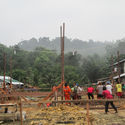.jpg?1465854467)
As director of the 2016 Venice Biennale, Alejandro Aravena has sought to shift the very grounds of architecture. Rather than an inward-looking interrogation of the profession's shortcomings, as Rem Koolhaas undertook in 2014, the Chilean Pritzker Prize-winner asks us to gaze in the opposite direction—to the vast swathes of the built horizon that traditionally lay beyond the profession's purview: urban slums, denatured megacities, conflict zones, environmentally compromised ports, rural villages far off the grid.
"We believe that the advancement of architecture is not a goal in itself but a way to improve people’s quality of life," states Aravena in his introduction to event. In other words, his biennale does not ask what architecture ought, yet often fails, to be, but rather what it could, yet often forgets, to do.



.jpg?1465854457)
.jpg?1465854487)

.jpg?1465854604)
















.gif?1465311775)



































.jpg?1464091234)

















